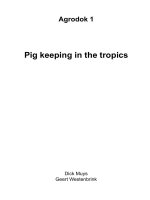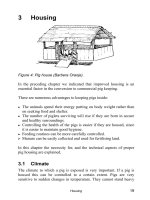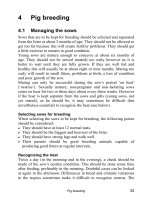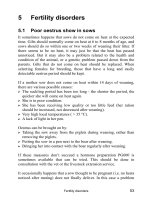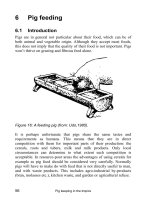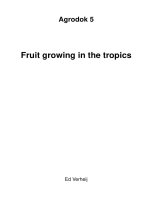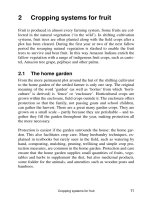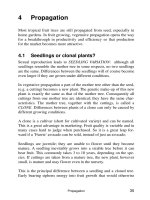Fruit growing in the tropics - Part 8 pptx
Bạn đang xem bản rút gọn của tài liệu. Xem và tải ngay bản đầy đủ của tài liệu tại đây (16.06 KB, 5 trang )
Crop protection
59
8 Crop protection
Crop protection practices are linked to the cropping system. The use
of commercial pesticides is by and large limited to orchards and large
plantations. In orchards of small trees, such as mandarin, guava or ap-
ple, pesticides are often used to excess. Intensive crop care drives up
the cost so much that the grower cannot risk crop failure; he tries to
protect his trees with whatever pesticide is recommended (and avail-
able). Routine spraying, without regard for the level of infestation, is
common. In this way the natural checks and balances between pests
and their predators in the orchard are disturbed, so that one treatment
breeds the need for the next one. Moreover, there are serious health
risks: for the grower who handles the materials and is exposed to the
spray drift; for the consumers when they eat the fruit; and for the crea-
tures living in the soil and nearby water courses that become polluted.
Tall trees cannot be treated with small (knapsack) sprayers and even
spraying of medium-sized trees in orchards (e.g. rambutan in Thai-
land, mango in the Philippines) is the exception rather than the rule. If
the orchard consists of a mixture of fruit crops it is hard to avoid pes-
ticide drifting onto non-target trees.
The scattered trees in home gardens, backyards, along field borders
and watercourses do not lend themselves to being sprayed with pesti-
cides. Several traditional crop protection measures are practiced in
home gardens, but mainly on small plants and in nursery work (e.g.
use of wood ash and plant extracts). On the trunks of tall trees in the
garden one often sees collars, made of metal sheeting or thorny
branches, to stop rodents from climbing the trees. Large fruit, such as
jackfruit, may be bagged to protect it against insects, birds and bats.
Smaller fruit (e.g. guava) is sometimes bagged too, in particular to
prevent fruit flies from laying their eggs there. On the whole home
gardeners hope that the rich mixture of plants will make it more diffi-
cult for pests or diseases to become a plague, but they also accept sub-
stantial losses as a fact of life.
Fruit growing in the tropics
60
8.1 Limiting use of pesticides
It is now realised that the use of pesticides should be drastically re-
duced by:
? Abandoning routine treatments
? Replacing broad-spectrum pesticides by products that kill the target
pest but do not harm other organisms.
This last approach is not easy, because you may find that the choice is
limited to pesticides used in the major cash crops in your area, such as
cotton or coffee. Selective pesticides for your crops may not be avail-
able.
Stopping routine spraying is also a problem: to be able to spray at the
right moment, the grower must first become familiar with pests and
diseases and their life cycles. These life cycles are usually tied to the
seasons and, especially for pests and diseases that complete their en-
tire life cycle on the tree, to the growth rhythm of the tree. Many dis-
eases, for instance, become rampant during the wet season: cankers,
such as pink disease (Corticium salmonicolor) can be found in many
fruit crops throughout the year, but they are spread mainly by rain.
Thus cankers can be controlled to a large extent by cutting out and
burning affected branches before the end of the dry season, so that
there are few sources of infection at the beginning of the rains.
Mango hoppers suck the young shoots and especially inflorescences;
they can ruin even a heavy bloom. Control using insecticides is diffi-
cult and depends on correct timing at the beginning of the flush. This
is only possible if all the trees flush simultaneously. Controlling the
crop cycle to ensure simultaneous flushing, flowering and fruiting
helps to time the treatments of pests whose life cycle is linked to that
of the tree (e.g. tip borers killing young mango shoots, stink bugs
puncturing the flowers of longan, and fruit borers and fruit flies on a
number of crops). The result is better control with fewer treatments,
and minimal disturbance of the natural environment.
Crop protection
61
Limiting the use of pesticides requires increased attention on other
ways to tackle pests and diseases:
? Hygiene
? Biological control: using other organisms to control pests and dis-
eases
? Disease-tolerant or disease-resistant cultivars or rootstocks.
Hygiene
Hygiene comes first. If you buy citrus trees in the nursery infected
with scales or mealy bugs, you fight a losing battle against these pests.
Start clean, stay clean!
The above example of cutting out and burning cankers of pink disease
before the rains come is also a matter of hygiene: clean up, choosing
the right moment. Bagging fruit on the tree, also mentioned above, is
laborious but can be very worthwhile where fruit flies, bats or birds
cause much damage and unblemished fruit commands a high price.
(Certain guava and mango cultivars are harvested and eaten green,
before the fruit fly maggots hatch from the eggs.)
Ants carry immobile insects around (also aphids, leaf hoppers and
some other insects) to young shoots, in order to milk them for the
honeydew that they secrete. Ants also protect these insects against
their natural enemies. So controlling ants is important. Sticky paper
collars fixed around the tree trunk catch the ants (and some other
wingless insects which try to climb the tree). If an insecticide is used
against ants it needs only be sprayed on the trunks.
Hygiene also means checking plants that are alternative hosts for a
pest or disease. This may be difficult, because information is lacking
or because you cannot do much to control alternative hosts. One prac-
tical example is kei apple, a very useful hedge plant in the highlands
but also a host for citrus fruit flies. All the grower has to do is to trim
hedges regularly so that they will not bear fruit. It is advisable to col-
lect fallen fruit because it is often infected by pests and/or diseases.
Fruit growing in the tropics
62
However, this is a lot of work, because it has to be done frequently
and each time the fruit has to be buried in a pit under a thick layer of
soil.
Biological control
Biological control has great potential, because every organism is sub-
ject to diseases and has natural enemies. Fungi and bacteria as well as
insects suffer from viruses and other bacteria or fungi. Insects are also
preyed upon by predators.
Biological control is expanding, although not as fast as it should.
Tropical fruits also benefit. Citrus growers, for instance, can learn
from their colleagues in the subtropics, where the number of treat-
ments with pesticides has been drastically reduced in favour of bio-
logical agents, restoring natural checks and balances. Leaf miners in
citrus for example, a very stubborn pest in spite of frequent spraying,
are less of a problem where these treatments are minimised. Aphids
have a range of predators: parasitic wasps, larvae of ladybirds, hover-
flies and lacewings. Parasitic wasps and ladybirds are raised and re-
leased in orchards in large numbers to control aphids.
Interesting forms of biological control came to light when trees were
successfully treated with Surround® to reduce heat stress and sunburn
in hot and dry conditions. Surround® simply consists of fine clay par-
ticles that give the tree a reflective coating when sprayed with water.
Treated trees suffered less from a wide range of pests, including mag-
gots, leafhoppers, caterpillars and psyllids. The white film on the
leaves confuses or repels some insects and acts as a barrier preventing
other insects from laying their eggs. A simple product opening up new
possibilities in crop protection!
Disease-tolerant cultivars
In several fruit crops disease-tolerant or resistant cultivars are becom-
ing available. Even rootstocks can play a role. Rootstocks tolerant to
root rot are recommended for avocado, rootstocks resistant to the
Tristeza virus for citrus. Purple passionfruit can be grafted on seed-
Crop protection
63
lings of yellow passionfruit that are resistant to soil-borne Fusarium
fungi. However, most of these tolerant/resistant cultivars and root-
stocks have their origins in the subtropics. For the truly tropical fruit
crops similar material is generally lacking.

